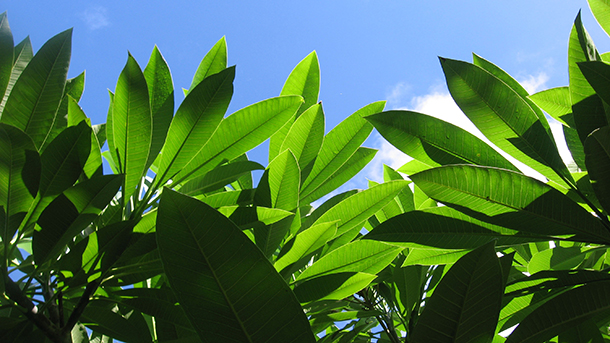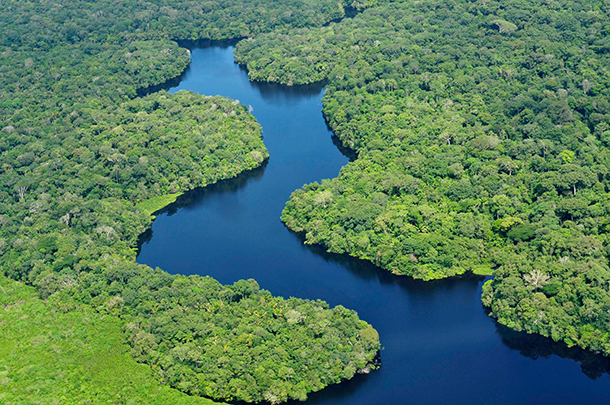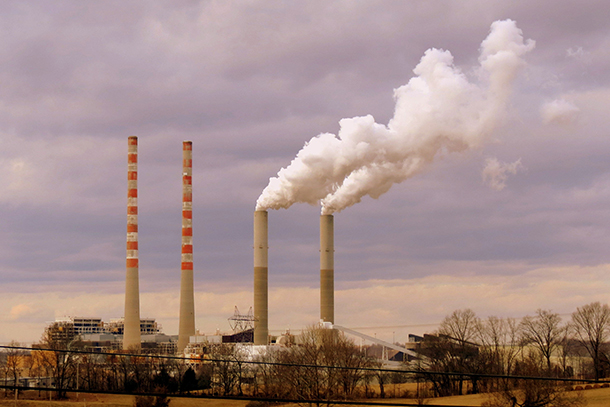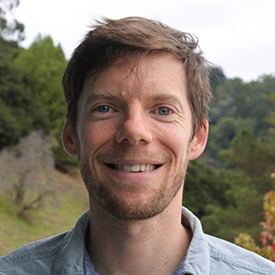Plants Fight Climate Change
Air Date: Week of November 25, 2016

Plants absorb more carbon dioxide through photosynthesis when atmospheric levels of the greenhouse gas are higher – until warmer temperatures begin to counteract this effect. (Photo: 16:9 clue, Flickr CC BY 2.0)
New research finds that plants are absorbing more carbon dioxide as atmospheric levels have risen, helping to counteract some of the extra CO2 humans are emitting. But as scientist Trevor Keenan tells host Steve Curwood, rising temperatures will soon hinder plants’ ability to take up excess carbon dioxide. Because many countries are banking on their ecosystems’ ability to absorb CO2, that could have serious implications for the world’s climate protection plans.
Transcript
In January of 2015 scientists found some 400 parts per million of carbon dioxide in the atmosphere, up from the 270 parts per million when the Industrial Age began in the late 1700s. All that extra CO2 in the air is warming the planet at a dangerous rate, scientists tell us, but we may have gotten a period of grace, thanks to green plants. Using photosynthesis, green vegetation soaks up carbon dioxide, and new research suggests that over recent decades rising CO2 levels have helped plants ramp up photosynthesis and slow the rate of global warming. But don’t expect the trend to last. According to researchers at the Lawrence Berkeley National Lab, it will soon be too hot for plants to keep absorbing so much added CO2. Trevor Keenan, the lead author on this research, is a Global Change Ecologist at the Lab and joins me now. Welcome to Living on Earth.
KEENAN: Thank you very much. Great to be here.
CURWOOD: So how excited are you by these results?
KEENAN: Well, these results are very exciting. We've known for decades that ecosystems have been taking up a lot of the carbon dioxide we emit into the atmosphere. Now they are not taking up near enough to really stop climate change, but they are going slowing it down significantly.

The world’s plants have been absorbing extra carbon dioxide for the last few decades. (Photo: Neil Palmer/CIAT for Center for International Forestry Research [CIFOR], Flickr CC BY 2.0)
CURWOOD: What if plants weren't doing this, taking up all the CO2. Where would we be?
KEENAN: We would be about 460 parts per million already. That's something we don't expect until about 2050 or 2060.
CURWOOD: How does this work scientifically? I mean, how can these plants increase the amount of carbon dioxide they are absorbing?
KEENAN: There are two effects. One is the plants use atmospheric CO2 to grow and to support their metabolism. So, they take CO2 to from the atmosphere, using a process called photosynthesis. The other major process that's involved is respiration. So, plants and microbes respire CO2 back into the atmosphere, and this is highly dependent on temperatures. So, as CO2 is going up, plants take more CO2 from the atmosphere, but as temperatures go up they also release more CO2 into the atmosphere because of the effect of temperature on respiration.
CURWOOD: So, in other words, it sounds like more CO2 will go into plants as long as temperatures stay low. But, if temperatures start to rise, then they won't be so interested in this, huh?
KEENAN: Exactly. As temperatures rise with CO2, that has a net negative effect on the carbon balance of the land surface and on ecosystems.
CURWOOD: So, how reassuring should this news be, if at all?
KEENAN: Not very. It's a period that is quite temporary. We expect temperatures to continue to increase in the future and they already have over the past two years with the large El Nino event we've seen globally, and the net effect of this is a release of carbon dioxide into the atmosphere. A lot of carbon goes into soils, and these soils are respiring. And dependence on temperature, and as temperature rises, that carbon that has been stored there could be released back into the atmosphere. That's super important because in the Paris Agreement that was signed recently, two-thirds of the countries said they would use the land sink to help them in their mitigation efforts.

If plants weren’t absorbing extra carbon dioxide, atmospheric levels might have already reached 460 parts per million, a level they aren’t projected to reach until the mid twenty-first century. (Photo: Brent Moore, Flickr CC BY-NC 2.0)
CURWOOD: Trevor, how were you and your colleagues able to determine that plants have increased their uptake of CO2 over these past few decades?
KEENAN: So, we have really good measurements of the amount of CO2 in the atmosphere. This has been measured very accurately over five decades since the ‘50s. And by examining changes in the amount of CO2 in the atmosphere over time, we can infer what is happening on the land surface and the oceans because we also know how much we're emitting into the atmosphere.
CURWOOD: Yes, so that raises one question. How do you know what's going into the ocean versus what's being taking up on the land here?
KEENAN: Primarily from a modeling approach. So, ocean models tend to agree very well with each other, and there's also a lot lower variability from year-to-year in the ocean than there is on land, so it's proportionally more easier to estimate how much carbon is going into the ocean. On lands, however, models disagree quite a lot, and there’s a lot of variability from year-to-year.
CURWOOD: Trevor, are you able to differentiate which plants are doing the best in this increased CO2 regime? In other words, are they big trees that are getting even bigger because of this, or are they little plants, grasses. Where do we see this uptake?
KEENAN: So, it's really not known. It is very complex to detect changes in biomass stocks over time. For example, estimates from satellite data and atmospheric data would say that a lot of this carbon dioxide is going into the tropics, but, when you measure tropical biomass over time, reports show very conflicting results. We also see greening at higher latitudes as the Earth warms, and these temperature limited systems are beginning to green, so a lot of carbon dioxide could be taken up by this new vegetation. And also in semi-arid regions, so regions which are water limited because increased CO2 in the atmosphere, another effect that it has, is makes plants more efficient at using water, so more vegetation can survive in regions that previously couldn't.
CURWOOD: Now, to what extent make this finding be misinterpreted by climate action skeptics and cited as evidence that CO2 is actually good for the planet, as some have suggested?

Trevor Keenan is a scientist in the Climate and Ecosystem Sciences division at Lawrence Berkeley National Laboratory in California. (Photo: Lawrence Berkeley National Laboratory)
KEENAN: Well, climate skeptics are keen to use whatever tidbits of information they can to justify their message, but ultimately it will be taken completely out of context. In any warming systems, especially a system as complex as the Earth's climate system, you expect brief periods where there is no warming apparent. Those periods ultimately end because the system is on the upper trajectory. So, although they could use results to say that CO2 is good for plants, it's really missing the whole picture. CO2 introduces warming locally, which as we know it is very detrimental, especially as we move further into the century and the kind of extreme temperatures we expect to see because of the CO2 is most definitely detrimental to plants, due to increased drought mortality, increase that fire frequencies globally. It really is quite a scary scenario we're looking at.
CURWOOD: Trevor Keenen is a Global Change Ecologist at Lawrence Berkeley National Lab. Thanks so much for taking the time with me today.
KEENAN: Thank you very much.
Links
The AmeriFlux Network measures carbon dioxide in North, Central and South America
Living on Earth wants to hear from you!
Living on Earth
62 Calef Highway, Suite 212
Lee, NH 03861
Telephone: 617-287-4121
E-mail: comments@loe.org
Newsletter [Click here]
Donate to Living on Earth!
Living on Earth is an independent media program and relies entirely on contributions from listeners and institutions supporting public service. Please donate now to preserve an independent environmental voice.
NewsletterLiving on Earth offers a weekly delivery of the show's rundown to your mailbox. Sign up for our newsletter today!
 Sailors For The Sea: Be the change you want to sea.
Sailors For The Sea: Be the change you want to sea.
 The Grantham Foundation for the Protection of the Environment: Committed to protecting and improving the health of the global environment.
The Grantham Foundation for the Protection of the Environment: Committed to protecting and improving the health of the global environment.
 Contribute to Living on Earth and receive, as our gift to you, an archival print of one of Mark Seth Lender's extraordinary wildlife photographs. Follow the link to see Mark's current collection of photographs.
Contribute to Living on Earth and receive, as our gift to you, an archival print of one of Mark Seth Lender's extraordinary wildlife photographs. Follow the link to see Mark's current collection of photographs.
 Buy a signed copy of Mark Seth Lender's book Smeagull the Seagull & support Living on Earth
Buy a signed copy of Mark Seth Lender's book Smeagull the Seagull & support Living on Earth

